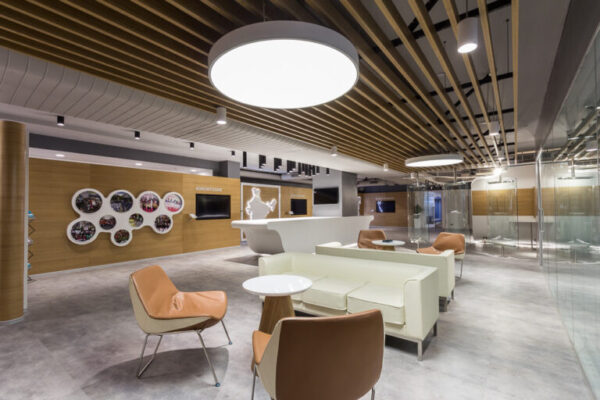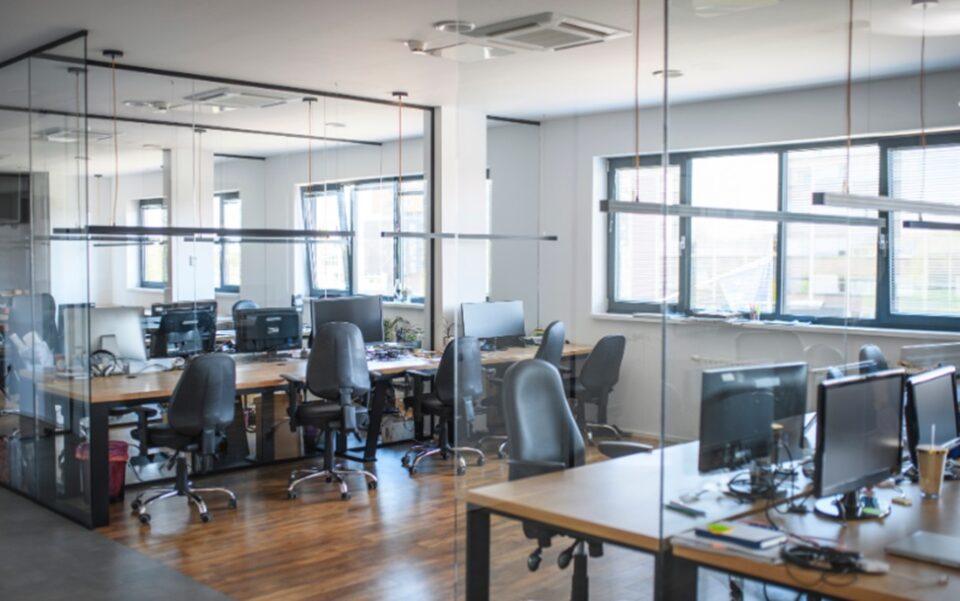Sustainable office interior design has become increasingly relevant as businesses seek to create environmentally conscious workspaces. Adopting eco-friendly office interior design not only promotes environmental responsibility but also improves the well-being of employees. Here are critical green solutions for your workspace that will help reduce your carbon footprint while fostering a more productive and healthy environment.
1. Use Recycled and Renewable Materials
Sustainable office interior design begins with the choice of materials. Opting for recycled or renewable resources, such as reclaimed wood, recycled metal, or bamboo, significantly reduces the environmental impact of office furniture and fixtures. These materials are eco-friendly and can add an aesthetic appeal to your workspace. Bamboo, for instance, proliferates, making it a renewable resource that is durable and stylish. Companies can contribute to a circular economy using such materials while creating a modern, sustainable office.
2. Maximise Natural Light
One of the simplest yet most effective green solutions is maximising natural light. Businesses can significantly reduce their reliance on artificial lighting by designing office layouts that prioritise large windows and open spaces. Natural light improves energy efficiency and boosts the well-being of employees, enhancing mood and productivity. Moreover, it can reduce the need for air conditioning by keeping the workspace cooler during warmer months. To further optimise natural light, consider using glass partitions and light-coloured walls that reflect light throughout the space.
3. Incorporate Energy-Efficient Lighting
Where artificial lighting is necessary, switching to energy-efficient solutions is essential for eco-friendly office interior design. LED lighting, in particular, is an excellent choice as it uses significantly less energy than traditional bulbs and has a longer lifespan. Smart lighting systems automatically adjust based on the time of day or occupancy, which can further reduce energy consumption. In addition to lowering electricity bills, energy-efficient lighting is crucial in reducing your office’s carbon emissions.

4. Implement Sustainable Office Furniture
When selecting office furniture, it’s essential to consider sustainability. Many companies now offer eco-friendly office furniture options from responsibly sourced or recycled materials. Furniture with modular designs is also an excellent choice, as it can be easily adapted or reconfigured, extending its lifespan. Look for certifications like FSC (Forest Stewardship Council) or Cradle to Cradle, ensuring the products meet high environmental standards. Sustainable furniture is not only better for the planet. Still, it can also contribute to a healthier indoor environment by minimising toxic emissions.
5. Create a Green Wall or Indoor Garden
Incorporating plants into your office space effectively enhances air quality and creates a calming atmosphere. Green walls, vertical gardens, or even simple indoor plants can absorb toxins, regulate humidity, and improve overall air quality. This biophilic approach to design supports sustainability and fosters a more serene and inspiring work environment. Studies show that exposure to nature can reduce stress and increase concentration, making it a valuable addition to any eco-friendly office interior design strategy.
6. Prioritise Waste Reduction
A key component of sustainable office interior design is reducing waste. Implementing a comprehensive recycling programme, encouraging digital documents over paper, and reducing single-use plastics can all contribute to a greener office. Additionally, selecting products with minimal packaging and designing spaces that allow for the easy sorting and collection of recyclables can significantly reduce office waste. Incorporating reusable office supplies, such as refillable pens and recycled paper, also helps minimise the environmental impact.
7. Choose Eco-Friendly Paints and Finishes
The type of paint and finishes you use in your office can impact both the environment and indoor air quality. Many conventional paints release volatile organic compounds (VOCs) that harm human health and the environment. Opting for low-VOC or VOC-free paints is an eco-friendly choice that improves air quality while reducing toxic emissions. Similarly, water-based finishes for furniture and flooring can further minimise environmental harm without compromising style or durability.
8. Focus on Energy Efficiency
Incorporating energy-efficient systems into your office is vital for reducing your carbon footprint. This can be achieved through various methods, such as installing energy-efficient HVAC systems, using programmable thermostats, and applying thermal insulation to regulate temperature. Smart technology solutions, including motion-sensor lighting and energy-monitoring systems, help reduce waste by ensuring that resources are only used when necessary. These solutions make your office more sustainable and lower operational costs in the long run.
9. Implement Water-Saving Solutions
Sustainable office interior design should also address water conservation. Simple solutions like installing low-flow faucets, dual-flush toilets, and water-efficient dishwashers can significantly reduce water consumption. Encouraging employees to be mindful of water use and regularly maintaining plumbing systems to prevent leaks will further contribute to water-saving efforts. Water scarcity is a growing global concern, so implementing these measures reflects your commitment to sustainability.
10. Encourage Sustainable Commuting Options
While the design of the office itself plays a significant role in sustainability, encouraging eco-friendly commuting options is another effective strategy. Providing facilities for cyclists, such as bike racks and shower areas, can motivate employees to cycle to work. Offering incentives for using public transport or carpooling can also reduce the overall carbon footprint of your office. Promoting sustainable commuting extends your green efforts beyond the workspace, contributing to a more environmentally conscious company culture.
Creating a sustainable office interior design requires a holistic approach encompassing everything from materials and lighting to waste management and energy efficiency. By incorporating these green solutions into your workspace, you reduce environmental impact and create a healthier, more productive environment for your employees.
For more information, contact Ampersand Associates today.

